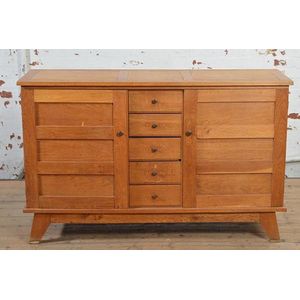Arts & Crafts Oak Sideboard with Mirror
You must be a subscriber, and be logged in to view price and dealer details.
Subscribe Now to view actual auction price for this item
When you subscribe, you have the option of setting the currency in which to display prices to $Au, $US, $NZ or Stg.
- Oak - Native to Europe and England, oak has been used for joinery, furniture and building since the beginning of the medieval civilisation. It is a pale yellow in colour when freshly cut and darkens with age to a mid brown colour.
Oak as a furniture timber was superceded by walnut in the 17th century, and in the 18th century by mahogany,
Semi-fossilised bog oak is black in colour, and is found in peat bogs where the trees have fallen and been preserved from decay by the bog. It is used for jewellery and small carved trinkets.
Pollard oak is taken from an oak that has been regularly pollarded, that is the upper branches have been removed at the top of the trunk, result that new branches would appear, and over time the top would become ball-like. . When harvested and sawn, the timber displays a continuous surface of knotty circles. The timber was scarce and expensive and was used in more expensive pieces of furniture in the Regency and Victorian periods. - Bevel / Chamfer - In furniture making, a chamfered corner refers to a technique used to create a smooth, angled edge on the corner of a piece of furniture. This is typically done by cutting away a small portion of the corner at an angle, typically 45 degrees, creating a diagonal edge, rather than a sharp 90-degree angle. This technique can be used on various parts of a piece of furniture such as table legs, drawer fronts, or door frames. Chamfering can add visual interest to a piece and can help to soften the overall look of a piece of furniture. It is often used in conjunction with other techniques, such as rounding edges or using contrasting wood species to create a more elegant, sophisticated look. Chamfering is a simple way to add a touch of elegance to a piece of furniture and it is a common technique used by furniture makers.
- Fluting - A form of decoration found on many pieces of furniture, as well as ceramics, silver and clocks, in which round-bottomed grooves, of varying width and depth, are let into columns, pilasters, legs. As a general rule, flutes are cut in the vertical, though they may follow a turned leg in a spiral pattern. In cross-section, they may be described as a series of 'U' shapes, rising and narrowing at each end of the groove. Fluting is the opposite of reeding, with which fluting is often associated.
- Plinth - The square or rectangular base of a piece of cabinet furniture, often ornamented with moulding. The plinth may be separate, as in some wardrobes or presses, and act as the support for the carcase. In a false plinth, the moulded boards may be attached directly to the piece. Furniture with a plinth base usually does not have separate feet. The term derives from architecture where it denotes the base of a column or statue.
This item has been included into following indexes:
- cabinets, material - oak 559
- cabinets, period or style - Arts & Crafts 29
-
sideboards
- Arts & Crafts 16
- oak 130
Visually similar items

A turn of the century kauri pine two height dresser with glazed doors to top, two drawers and one door to base 190 x 140 x 64 cm

An Australian Federation kauri pine country kitchen dresser in untouched condition, 210 x 122 x 116 cm

18th century oak court cupboard, of good proportions. The upper section with panelled cupboards, the lower section with two drawers above panelled cupboards. Height 175 cm width 114 cm

Rene Gabriel two door sideboard with central section of five drawers oak with brass handles France, c. 1950s
